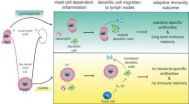(Press-News.org)
VIDEO:
A pair of studies published by Cell Press on February 14th in the journal Cell sheds new light on genetic variation that may have played a key role in human...
Click here for more information.
A pair of studies published by Cell Press on February 14th in the journal Cell sheds new light on genetic variation that may have played a key role in human evolution. The study researchers used an animal model to study a gene variant that could have helped humans adapt to humid climates, and they used whole-genome sequence data to identify hundreds of gene variants that potentially helped humans adapt to changing environmental conditions over time. The findings provide a road map for understanding human biological history as well as modern-day variability.
"There is an archaeological record hidden in our DNA that can help point us to the traits that have been critical in human survival, such as resistance to infectious diseases and new abilities to respond to different environments," says senior study author Pardis Sabeti of Harvard University and the Broad Institute. "The two studies have uncovered two intriguing human adaptive traits and demonstrate the ability to go from an unbiased genome scan to a novel hypothesis of human evolution."
Sabeti and her team found that a previously reported variant of the EDAR gene, which arose in central China about 30,000 years ago, increased the number of sweat glands in genetically modified mice and had other effects not previously reported in humans; their discovery demonstrates that animal models can be used to study the biological changes expected to result from human genetic variation. This gene variant was also associated with an increase in the number of sweat glands in a present-day Han Chinese population. By enhancing sweating, this EDAR variant could have helped humans adapt to humid climates that may have existed in China 30,000 years ago.
In the accompanying study, the researchers used data from the 1000 Genomes Project to analyze DNA sequence variations across the entire genome. They identified hundreds of gene variants that potentially contributed to human evolutionary adaptation. One of these variants, a mutation in the TLR5 gene, changed the immune responses of cells exposed to bacterial proteins, suggesting that this variant could confer a fitness advantage by protecting against bacterial infections. The comprehensive list of possible adaptive mutations driving recent human evolution provides the groundwork for future studies.
Together, the two studies represent a decisive shift for the field of evolutionary genomics, transitioning from hypothesis-driven to hypothesis-generating science. By moving from genome-wide scans to the characterization of adaptive mutations, it is possible to elucidate distinct mechanisms of evolution.
"These two studies are the product of work done in this area for over a decade but can only now be made possible with the major breakthroughs in genomic technology," Sabeti says. "I am struck by the ability of genomics to uncover the secrets of human history."
INFORMATION:
Cell, Grossman et al.: "Identifying Recent Adaptations in Large-scale Genomic Data."
Cell, Kamberov et al.: "Modeling recent human evolution in mice by expression of a selected EDAR variant."
2 Cell studies reveal genetic variation driving human evolution
2013-02-14
ELSE PRESS RELEASES FROM THIS DATE:
Bilingual babies know their grammar by 7 months
2013-02-14
Babies as young as seven months can distinguish between, and begin to learn, two languages with vastly different grammatical structures, according to new research from the University of British Columbia and Université Paris Descartes.
Published today in the journal Nature Communications and presented at the 2013 Annual Meeting of the American Association for the Advancement of Science (AAAS) in Boston, the study shows that infants in bilingual environments use pitch and duration cues to discriminate between languages – such as English and Japanese – with opposite word ...
First animal model of recent human evolution
2013-02-14
The first animal model of recent human evolution reveals that a single mutation produced several traits common in East Asian peoples, from thicker hair to denser sweat glands, an international team of researchers reports.
The team, led by researchers from Harvard Medical School, Harvard University, the Broad Institute of MIT and Harvard, Massachusetts General Hospital, Fudan University and University College London, also modeled the spread of the gene mutation across Asia and North America, concluding that it most likely arose about 30,000 years ago in what is today ...
Defect in immune memory may cause repeat bladder infections
2013-02-14
DURHAM, N.C. – Recurrent bladder infections, which are especially common among women, may result from a defect among the bladder's immune fighters that keeps them from remembering previous bacterial infections. The immune memory lapse can hamper a timely and effective attack, according to researchers at Duke Medicine and Duke-National University of Singapore.
Their study, which involved mice, may provide a new route to develop vaccines and treatments for urinary tract infections, which are the second-most common infection and account for more than 8 million health care ...
Discovery in HIV may solve efficiency problems for gene therapy
2013-02-14
A research team from Case Western Reserve University School of Medicine has discovered an approach that could make gene therapy dramatically more effective for patients.
Led by professor Eric Arts, PhD, the scientists discovered that the process of gene therapy is missing essential elements thereby reducing the effectiveness of this treatment. Re-introducing this element into their model system suggests that improvements for gene therapy areon the horizon.
The findings are detailed in the article, "A new genomic RNA packaging element in retroviruses and the interplay ...
Study tracks leukemia's genetic evolution, may help predict disease course, tailor care
2013-02-14
BOSTON AND CAMBRIDGE, Mass.––Tumors are not factories for the mass production of identical cancer cells, but are, in reality, patchworks of cells with different patterns of gene mutations. In a new study, researchers at Dana-Farber Cancer Institute and the Broad Institute show, more fully than ever before, how these mutations shift and evolve over time in chronic lymphocytic leukemia (CLL) – providing a strobe-like look at the genetic past, present, and future of CLL tumors.
Their report, which will be published online today by the journal Cell, suggests that evolution ...
Gene invaders are stymied by a cell's genome defense
2013-02-14
Gene wars rage inside our cells, with invading DNA regularly threatening to subvert our human blueprint. Now, building on Nobel-Prize-winning findings, UC San Francisco researchers have discovered a molecular machine that helps protect a cell's genes against these DNA interlopers.
The machine, named SCANR, recognizes and targets foreign DNA. The UCSF team identified it in yeast, but given the similarity of yeast and human cells, comparable mechanisms might also be found in humans, where they might serve to lower the burden of inherited human disease and death, the researchers ...
Environment schemes for kids influence parents' behavior
2013-02-14
Teaching children about the environment can affect the knowledge and behaviour of their parents, according to new research.
Scientists from Imperial College London surveyed the families of 160 schoolchildren in the Seychelles, some of whom took part in educational activities about the island's valuable wetland resources.
They found that the parents of children who took part in the wetland activities were more knowledgeable about wetlands and, were more inclined to undertake 'environmentally friendly' behaviours such as conserving water in their homes.
The findings ...
Our primitive reflexes may be more sophisticated than they appear, study shows
2013-02-14
Supposedly 'primitive' reflexes may involve more sophisticated brain function than previously thought, according to researchers at Imperial College London.
The Vestibular-Ocular Reflex (or VOR), common to most vertebrates, is what allows us to keep our eyes focused on a fixed point even while our heads are moving. Up until now, scientists had assumed this reflex was controlled by the lower brainstem, which regulates eating, sleeping and other low-level tasks.
Researchers at Imperial's Division of Brain Sciences conducted tests to examine this reflex in left- and right-handed ...
Indian plant could play key role in death of cancer cells
2013-02-14
AUGUSTA, Ga. – Scientists at the Georgia Regents University Cancer Center have identified an Indian plant, used for centuries to treat inflammation, fever and malaria, that could help kill cancer cells.
Cancer cells typically avoid death by hijacking molecular chaperones that guide and protect the proteins that ensure normal cellular function and then tricking them into helping mutated versions of those proteins stay alive, says Dr. Ahmed Chadli, a researcher in the Molecular Chaperone Program at the GRU Cancer Center and senior author of the study named the Journal ...
New LA BioMed research identifies effective treatment for common gynecological problem
2013-02-14
LOS ANGELES (Feb. 14, 2013) – New research from the Los Angeles Biomedical Research Institute (LA BioMed) found a progestogen-only treatment halted bleeding in women suffering from extremely heavy periods, according to the study published online by the American Journal of Obstetrics and Gynecology.
"Excessive uterine bleeding is a common problem we see in gynecological practices and emergency rooms. It can interfere with women's daily activities and put them at risk for anemia and other more serious health consequences caused by blood loss," said Anita L. Nelson, MD, ...





